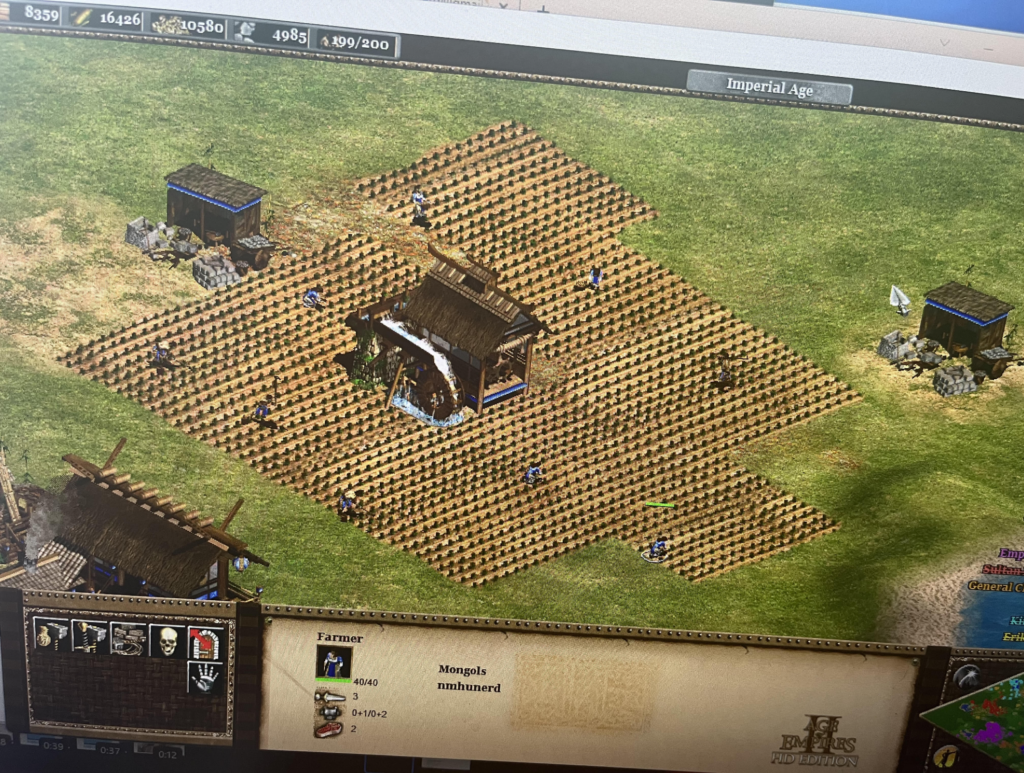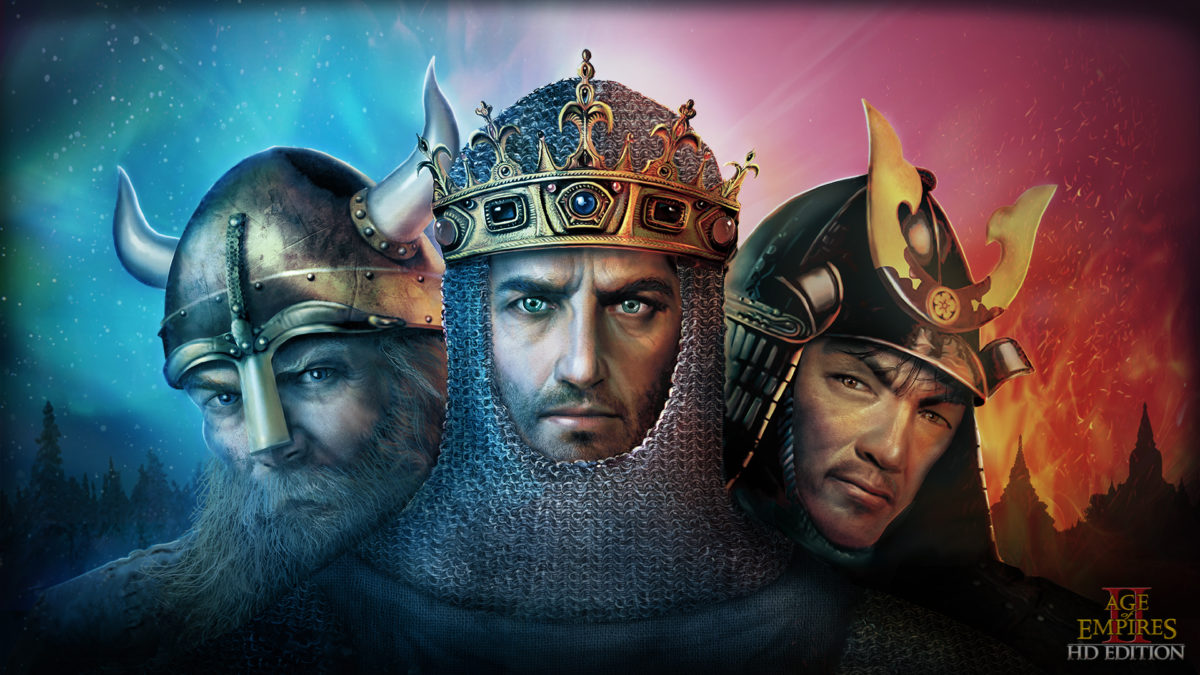Many years later, as I face my laptop now, I remember a distant afternoon in 2002 when my cousin in college took me to discover Age of Empires II. While enjoying the old game two decades later, I noticed some issues from the perspective of environmental humanities. Different from other critical perspectives, such as feminism and postcolonialism, which are embedded in anthropocentrism, the environmentalist methodology may cast light on the representation of relationship between humankind and non-human-beings on the earth. In particular, it could disclose the influence of modernity on historical representation in RTS games. While the historical setting is “based on the Middle Ages,” the exploitative view of nature in the game is very much modern and colonial (Shelley, 1999, 365). In her research on the Age of Empires series, Beth A. Dillon notes that, “the player is forced to enact the narrative in a colonialist manner, concerned only with expansion and depleting resources. Once resources in your area are depleted, you are encouraged to defeat nearby enemies to take over their resources” (Dillion, 2008, 132). In addition to Dillion’s insights, this essay attempts to demonstrate how the modernist perception of the environment is embodied in the historical game.
Collecting resources: an exploitative view of nature
The “campaign” model in Age of Empires II covers the stories of important medieval figures, such as Joan of Arc. In her campaign’s first scenario, “An Unlikely Messiah,” the objectives require players to “escort Joan from the camp at Vaucouleurs to the Chateau of Chinon.” During this journey, Joan encounters geographical barriers and non-human creatures. The most convenient route is hindered by rivers and cliffs, which are worsened by wolves. The scenario exemplifies one perception of the natural environment in the game as a threat.

In the “standard game” model, the perception of nature is more complicated. In Age of Empires II, players need to “manage four different resources” (Shelley, 1999, 5). They are all gathered from nature: stone and gold dug out from the mines, wood obtained from jungle and forest, and foods fetched from food-producing plants and animals. In this sense, the natural environment is reduced to these natural resources in the game setting.

The acquisition of food is the most violent among the four types of resources. As a vegetarian, I feel uncomfortable watching the cruel scene of slaughtering animals as a routine part of the game while never noticing that during my childhood. Besides “harmful creatures” such as the wolves mentioned above, most other animals in the game are depicted as useful sources of food: deer, sheep, and other species which could not hurt humans but only be hunted. The only exceptions to this dualism are wild boars, which are described as a mixture of useful and harmful creatures in the game. While hurting humans in their hunting activities, wild boars provide more than twice as much food as other food-producing animals: “deer contain 140 foods and wild boars contain 340 foods” (Shelley, 1999, 15).
Besides animals, the human-centric useful-harmful dualist view of nature also influences the description of human-plant relations in the game. As an important source of food, the berry bush certainly could be classified as a “useful” plant. As well as providing food, plants are also an important supply of wood in the game. Despite the appearance of diversity of plants in different maps, they are homogeneously perceived as the source of wood in the game.
In addition to providing wood, the distribution of forests could affect human activities in the game. Taking the map type “Black Forest” as an example, it “is mostly forest with small, winding paths to each player” (Shelley, 1999, 49). Players need to command their villagers to cut down trees using machetes at the beginning. When upgrading their civilizations, players can develop the “Onager” or “Siege Onager” technology in the Siege Workshop building. The two units “can attack ground and destroy trees” while not transforming the “harmful” natural barriers into “useful” natural resources (Anonymous). Hence, the setting of most “natural” resources in the multiplayer pattern of the game embodies the human-centric and useful-harmful logic.
As an integral part of the “strategy” in this RTS game, the central role that resource-gathering activities play reflects the prevalent view of nature in the modern world. In premodern society, people did not treat nature as a resource. As historian Christian Rohr indicates, “nature is not only the uncultivated part of environment, but also the sum of living behaviours in general, the relationship between god and human beings, the explanations of the universe and of life in particular” (Rohr, 2000, 1). Despite its medieval setting, the view of nature in the Age of Empires is embedded in modernity instead of medievality.
Besides this game, the exploitative view of nature is very common in other RTS games. In advance of Age of Empires II, Starcraft was released in 1998. With a far-future setting, this game describes a 26th-century world dominated by humans (Terran) and alien creatures (Zerg and Protoss), while the relations between these creatures and nature seem not significantly distinct from the present. Players need to gather the two useful natural resources, minerals and vespene gas. Originating in the pioneering RTS game Dune II, exploiting nature by gathering resources has to be one of the conventions of this genre.
An anthropocentric view of nature
While taking a critical reappraisal of the view of nature underlying RTS games’ resource gathering, this essay does not intend to blame their designers for negligence of environmental justice. The exploitative view of nature predominating in these games is emblematic of the prevalent understanding of nature in the Anthropocene, in which human beings perceive themselves as masters of nature. As articulated in ecofeminists Maria Mies and Vandana Shiva’s critique on modernity, “the human being is conceived of, not as part of nature, but as nature’s master and lord” (Mies and Shiva, 1993, 184). Through the lens of Age of Empires II, this essay draws game scholars’ attention to how real-world values and worldviews are reflected in real-time games.
Shu Wan is currently matriculated as a doctoral student in history at the University at Buffalo. He is strongly interested in historical representation in video games and the use of games in teaching history.
References
A. (n.d.). An unlikely messiah. Retrieved May 30, 2022, from https://ageofempires.fandom.com/wiki/An_Unlikely_Messiah
Dillon, B. A. (2008). Signifying the west: Colonialist design in age of empires III: The warchiefs. Eludamos: Journal for Computer Game Culture, 2(1), 129–144. https://doi.org/10.7557/23.5975
Mies, M., & Shiva, V. (1993). Ecofeminism. Zed Books.
Rohr, C. (2000). Man and nature in the Middle Ages – sbg.ac.at. Retrieved August 13, 2022, from https://www.sbg.ac.at/ges/people/rohr/nsk01.pdf
Shelley, B. C. (1999). Official Strategies and secrets to Microsoft’s age of empires II, the age of kings. Sybex.

0 replies on “Is the Age of Empires II an Age of Exploiting Nature, too?”
This is absolute nonsense. Age of Empires isn’t like that because of modern values being shoehorned in, it’s exactly how humans have acted for thousands of years. If anything we’re less like that now than we have ever been.
If you don’t want to play it the way it was intended then don’t. Just leave your villagers stood there doing nothing.